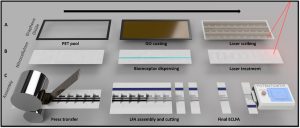
Research in electrochemical detection in lateral flow assays (LFAs) has gained significant momentum in recent years. The primary impetus for this surge in interest is the pursuit of achieving lower limits of detection, especially given that LFAs are the most widely employed point-of-care biosensors. Conventionally, the strategy for merging electrochemistry and LFAs has centered on the superposition of screen-printed electrodes onto nitrocellulose substrates during LFA fabrication. Nevertheless, this approach poses substantial limitations regarding scalability. In response, we have developed a novel method for the complete integration of reduced graphene oxide (rGO) electrodes into LFA strips. We employed a CO2 laser to concurrently reduce graphene oxide and pattern nitrocellulose, exposing its backing to create connection sites impervious to sample leakage. Subsequently, rGO and nitrocellulose were juxtaposed and introduced into a roll-to-roll system using a wax printer. The exerted pressure facilitated the transfer of rGO onto the nitrocellulose. We systematically evaluated several electrochemical strategies to harness the synergy between rGO and LFAs. While certain challenges persist, our rGO transfer technology presents compelling potential for setting a new standard in electrochemical LFA fabrication. [Link to the article]